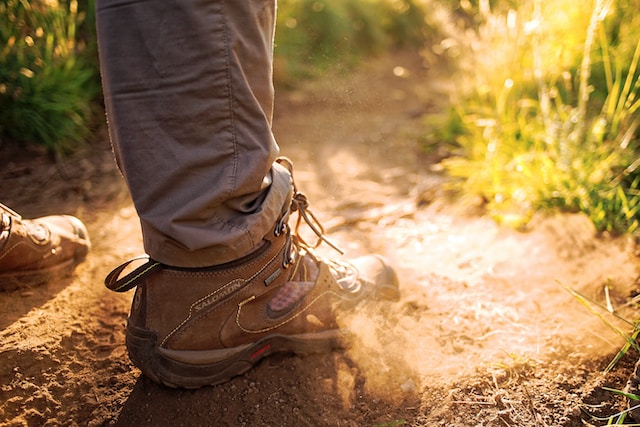 Foto von Fidel Fernando auf Unsplash
Foto von Fidel Fernando auf Unsplash
Walking boots, also known as controlled ankle motion (CAM) boots, are vital orthopaedic devices designed to aid recovery after foot or ankle injuries. These supportive and stabilizing boots offer a range of benefits, yet their prolonged use can also present challenges. This article delves deeply into the positive effects of walking boots, exploring their role in pain relief, stability, post-surgery rehabilitation, and psychological well-being.
It also addresses the side effects of wearing a walking boot, such as discomfort, muscle atrophy, dependency, posture issues, and the emotional impact of their usage.
Positive Effects of Walking Boots
- Pain Relief and Support
One of the fundamental benefits of walking boots is their ability to provide substantial pain relief and support to individuals recovering from injuries. By immobilizing the injured foot or ankle, these boots reduce pressure on sensitive areas, allowing natural healing. This pain alleviation enhances the overall healing experience and promotes a sense of comfort and security for the wearer.
- Stability and Mobility
Walking boots are engineered to enhance stability during movement. By offering a secure environment for the affected foot, these boots prevent further damage while enabling patients to maintain mobility. This stability is vital, especially during the early stages of recovery, as it reduces the risk of re-injury and accelerates the healing process.
- Post-Surgery Rehabilitation
Walking boots play a crucial role in rehabilitation after orthopaedic surgeries. They facilitate weight distribution, enabling patients to engage in prescribed physical therapy exercises. This active involvement in rehabilitation strengthens the injured area and improves overall mobility, fostering a faster and more comprehensive recovery.
- Preventing Further Injury
Walking boots act as a protective barrier, shielding vulnerable bones and tissues from external impact. They also help you walk without any worries after knee replacement. By restricting weight-bearing on the injured area, these boots minimize the risk of complications and re-injury. This prevention of further damage is essential for patients‘ long-term well-being, ensuring a smooth recovery trajectory.
- Psychological Benefits
Beyond their physical advantages, walking boots offer significant psychological benefits. These devices enhance the wearer’s confidence and mental well-being by restoring mobility and independence. Patients regain control over their movements, leading to improved self-esteem and a more positive outlook on the healing process.
Negative Effects of Walking Boots
- Discomfort and Skin Irritation
Despite their advantages, walking boots can cause discomfort and skin irritation, especially with prolonged use. Pressure points within the boot may lead to soreness and, in some cases, skin abrasions. Patients must promptly communicate discomfort, allowing healthcare providers to adjust the boot or provide additional padding to mitigate these issues.
- Muscle Atrophy and Joint Stiffness
Limited movement within the confines of a walking boot can result in muscle atrophy and joint stiffness. To counteract these effects, patients are often encouraged to perform specific exercises designed to target the affected muscles and joints. Physical therapy plays a vital role in maintaining muscle strength and joint flexibility during recovery.
- Dependency and Reduced Physical Activity
While walking boots promote stability, they can inadvertently foster dependency, limiting patients‘ participation in regular physical activities. Striking a balance between rest and controlled movement is essential. Patients are encouraged to engage in non-weight-bearing exercises and activities promoting cardiovascular health, ensuring overall physical well-being during recovery.
- Potential Impact on Posture
The altered gait caused by walking boots can impact posture, potentially leading to complications. Patients may develop compensatory habits, leading to postural issues. Rehabilitation strategies, including physiotherapy and posture-correcting exercises, are essential for restoring proper alignment and minimizing long-term posture-related problems.
- Social and Emotional Impact
The limitations of walking boots can lead to social isolation and emotional challenges. Patients may feel restricted in social interactions and experience frustration or sadness due to limited mobility. Support from healthcare providers, friends, and family members is invaluable in addressing these emotional aspects of recovery. Additionally, joining support groups or online communities can provide a sense of belonging and understanding during this challenging period.
Conclusion
Walking boots are invaluable in orthopaedic medicine, offering crucial support and stability to individuals recovering from foot and ankle injuries. Understanding their positive and negative effects is essential for patients and healthcare providers. By acknowledging and proactively managing the challenges, patients can maximize the benefits of walking boots while minimizing their adverse effects. Effective communication between patients and healthcare professionals and tailored rehabilitation programs ensure a holistic and successful recovery journey. Embracing a comprehensive approach to healing, both physically and emotionally, is key to overcoming the hurdles associated with wearing walking boots and achieving a swift return to normalcy.

